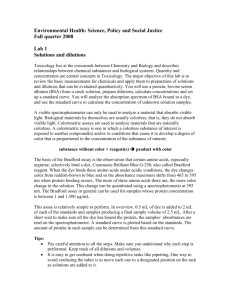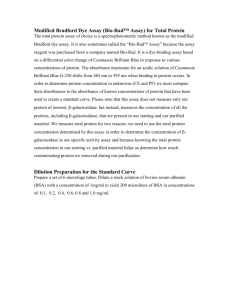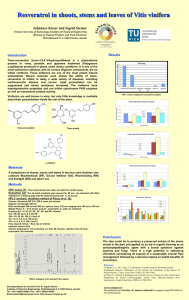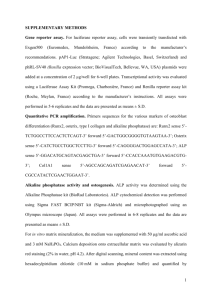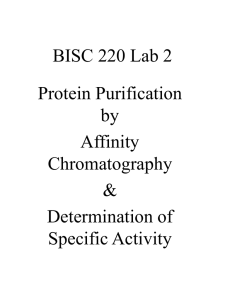Lab # 2: Quantitative Protein Assay
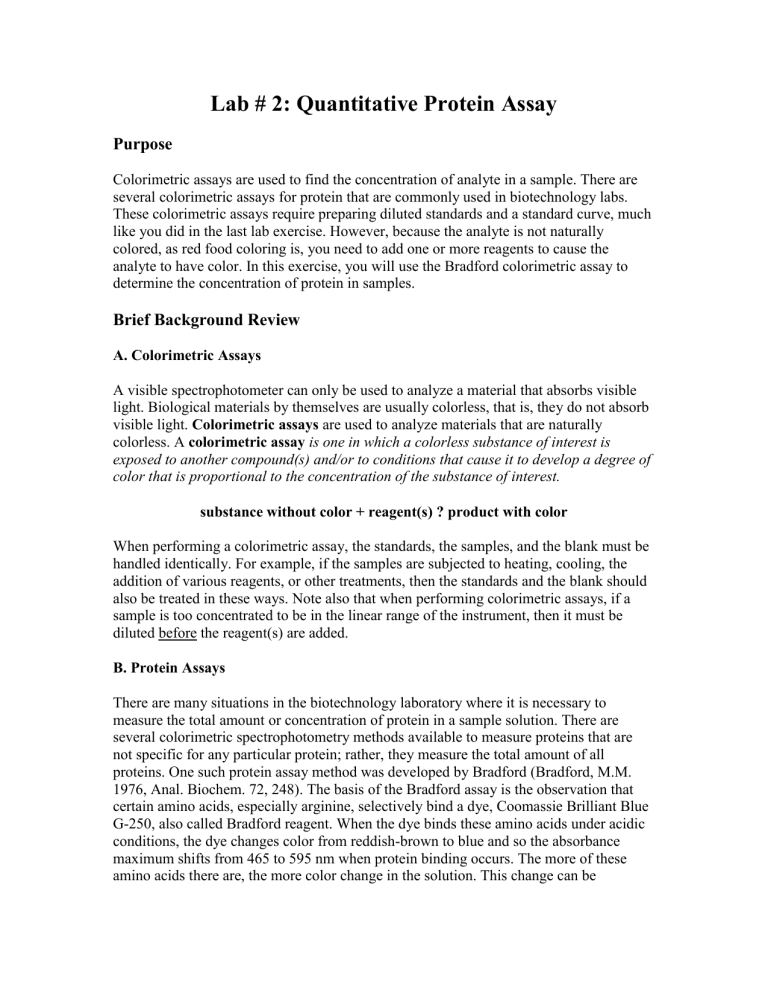
Lab # 2: Quantitative Protein Assay
Purpose
Colorimetric assays are used to find the concentration of analyte in a sample. There are several colorimetric assays for protein that are commonly used in biotechnology labs.
These colorimetric assays require preparing diluted standards and a standard curve, much like you did in the last lab exercise. However, because the analyte is not naturally colored, as red food coloring is, you need to add one or more reagents to cause the analyte to have color. In this exercise, you will use the Bradford colorimetric assay to determine the concentration of protein in samples.
Brief Background Review
A. Colorimetric Assays
A visible spectrophotometer can only be used to analyze a material that absorbs visible light. Biological materials by themselves are usually colorless, that is, they do not absorb visible light. Colorimetric assays are used to analyze materials that are naturally colorless. A colorimetric assay is one in which a colorless substance of interest is exposed to another compound(s) and/or to conditions that cause it to develop a degree of color that is proportional to the concentration of the substance of interest.
substance without color + reagent(s) ? product with color
When performing a colorimetric assay, the standards, the samples, and the blank must be handled identically. For example, if the samples are subjected to heating, cooling, the addition of various reagents, or other treatments, then the standards and the blank should also be treated in these ways. Note also that when performing colorimetric assays, if a sample is too concentrated to be in the linear range of the instrument, then it must be diluted before the reagent(s) are added.
B. Protein Assays
There are many situations in the biotechnology laboratory where it is necessary to measure the total amount or concentration of protein in a sample solution. There are several colorimetric spectrophotometry methods available to measure proteins that are not specific for any particular protein; rather, they measure the total amount of all proteins. One such protein assay method was developed by Bradford (Bradford, M.M.
1976, Anal. Biochem. 72, 248). The basis of the Bradford assay is the observation that certain amino acids, especially arginine, selectively bind a dye, Coomassie Brilliant Blue
G-250, also called Bradford reagent. When the dye binds these amino acids under acidic conditions, the dye changes color from reddish-brown to blue and so the absorbance maximum shifts from 465 to 595 nm when protein binding occurs. The more of these amino acids there are, the more color change in the solution. This change can be
quantitated using a spectrophotometer at 595 nm. The Bradford assay in general can be used for samples whose protein concentration is between 1 and 1,500 g/mL.
The Bradford assay has been developed by several companies and packaged into an easy to use kit. The company provides the dye solution at the correct pH. The dye is simply added to the samples of interest and also to standards with known concentrations of protein. The amount of protein in the samples is determined by comparison with a standard curve generated by using the standards.
To prepare a standard curve, we measure the absorbance of protein standards of known concentration. It is best to prepare standards using whatever protein is of interest.
However, it is often difficult or expensive to obtain the protein of interest in sufficient quantity to use it to prepare standards. Therefore, the stable and relatively inexpensive protein, bovine serum albumin (BSA), is routinely used to prepare standards for protein assays. We will likewise use BSA to make our standards.
This assay is relatively simple to perform. In overview, 0.2 mL of dye is added to 0.8 mL of each of the standards and samples producing a final sample volume of 1 mL. After a short wait to make sure all the dye has bound the protein, the samples’ absorbances are read on the spectrophotometer. A standard curve is plotted based on the standards. The amount of protein in each sample can be determined from this standard curve.
C. Important Tips
Write out your own procedure in your own words in your laboratory notebook. Pay careful attention to all the steps. Make sure you understand why each step is performed.
Keep track of all dilutions and volumes.
When performing any spectrophotometric assay, it is usually necessary to use standards and samples that are diluted in such a way as to obtain values in the linear range of the standard curve. Often the necessary dilution factors will change as you move through a purification procedure, or advance in an experiment. You may need to determine the correct dilutions largely through trial and error.
Pipetting small volumes (1-20 µL) is sometimes tricky. Figure out a system to minimize pipetting errors. One method is to put the water in the tube first and then pipette the stock solution (in this case, BSA) carefully into the water, rinsing the tip by pipetting up and down several times.
It is easy to get confused when doing repetitive tasks like pipetting. One way to avoid confusing the tubes is to move each one to a designated position on the rack as solutions are added to it.
Proteins are typically found in solution along with detergents, buffers, denaturing agents, reducing agents, preservatives, and other materials. These other substances can affect the results of a protein assay. When a component in the solution other than the material of
interest either enhances or reduces the amount of color formed in the assay, that
component is called an interfering substance . Each type of protein assay is sensitive to interfering substances. Certain common detergents are interfering substances for the
Bradford assay. Assay are not accurate if interfering substances are present in the reaction mix and so either they should be avoided, or a different assay method must be used.
Laboratory Activities
1.
Turn on the spectrophotometer and set the wavelength to 595 nm .
2.
Prepare the Standards and Blank . a.
Starting with a BSA stock solution of 1.0 mg/mL, make a series of 5 dilutions in water with final concentrations ranging from 1 to 25 µg/mL.
Each dilution should have a volume of 4.0 mL. These are your standards.
Table 1 below is designed to help you with your dilutions. The first line of the table has been filled out for you; use this as a guide to complete the table. b.
In addition, prepare a tube with 4.0 mL of water that will serve as your blank for the spectrophotometer.
Tube
Number
1
2
3
4
5 blank
Final BSA
Concentration
1.0 µg/mL
5.0 µg/mL
10.0 µg/mL
20.0 µg/mL
25.0 µg/mL
0.00
*Volume of Stock Solution
4 µL
0
Volume of H
2
O
3.996 mL
4.000 mL
* To determine the amount of stock you will need to make the desired final protein concentrations, use the C
1
V
1
= C
2
V
2
equation, where C
1
and C
2
are the concentrations of the stock and the diluted sample respectively and V
1
and V
2
are the volumes of the stock and the diluted sample. For example, for the first standard:
C
1
V
1
= C
2
(1000 µg/mL) (?) = (1 µg/mL) (4 mL)
V
2
? = 0.004 mL = 4 µL
Add water to make up to 4 mL
3.
Prepare the Unknowns . Your instructor will give you a sample of BSA of unknown concentration and you will determine the concentration of protein in this sample. To do this, you will need to assay a sample that is in the range of the standards you have prepared, 1-25 µg/mL. Since you do not know how much protein there is in the unknown sample that you receive from your instructor, you should prepare several dilutions. (What should you use as your diluent?) Note that if none of those dilutions lie within the linear range of the assay, you will need to repeat the entire assay, standards and all. You will need four milliliters of each dilution.
4.
Conduct a Check . At this point you should have 5 standards, a water blank and several different dilutions of your BSA unknown sample. All standards, samples and the blank should have a volume of 4.0 mL. Hold the rack of tubes up to your eyes. If the volumes are not equivalent, do not proceed because the assay will not be accurate and you will be wasting reagents and time if you continue.
5.
Add Dye . Add 1.0 mL of Bio-Rad dye to each of the assay tubes. Mix the tubes gently but thoroughly after the addition of the dye using either a vortex mixer set to a low power setting or by gently flicking the tubes. Avoid foaming.
6.
Check for Color . After 5-15 minutes, check to see that color is developing.
Solutions without protein should still be reddish brown. Solutions with protein should turn blue: the more concentrated the protein, the more blue the solution should be. You should be able to see the progression of the color in the standard tubes. If not, something is wrong.
7.
Read and Record the Absorbances . After a period of 10 minutes to 1 hour, read the tubes at 595 nm on the spectrophotometer. The spectrophotometer should be calibrated using water as the blank. Start with the most dilute solution and progress to the most concentrated. Be careful to thoroughly remove each solution from the cuvette after reading its absorbance. Save each solution by putting it back into its tube in case you need to read it again. Record your absorbance values on Table 2.
8.
Prepare the Standard Curve . Graph the spectrophotometer readings of your diluted BSA standards as a function of concentration of protein present. The xaxis is "BSA (in µg/mL)" and the y-axis is "A
595
".
9.
Determine the Concentration of Protein in the Unknown Sample(s) .
Determine the concentration of protein in your unknown(s) by using your standard curve. Add the results to your data table. If the samples were diluted, multiply by the dilution factor to determine their concentration.
10.
Compare Your Answers for the Unknowns with the Answer Key.
Sample
Standard 1
Standard 2
Standard 3
Standard 4
Standard 5
Blank 6
Unknown 7
Unknown 8
Unknown 9
Unknown 10
Tube #
*
*
*
*
1.0
5.0
10.0
20.0
25.0
0.00
Concentration of
Protein (µg/mL)
A
595
* Read this value off the standard curve.
Discussion Questions
1.
What factors do you think could make this assay method inaccurate? How can you avoid these problems?
2.
Examine your standard curve. Evaluate your pipetting technique based on this standard curve.
3.
Did you successfully determine the concentration of protein in your unknown sample(s)? How close were you to the result on the answer key. Calculate the per cent error(s). Is your result “close enough”? Evaluate your success with the
Bradford method.
1 mg/mL BSA protein standard micropipette tips 10-100 µL test tube racks, cuvette rack
1mL / group micropipette tips 0.5-10 µL
1 box / group
1 each / group micropipette tips 100-1000µL liquid waste container
1 box / group
1 box / group
1 / group sharpie marker, labeling tape
13x100 mm test tubes
1 / group)
15 / group distilled water
BioRad Dye Conc. cat. # 500-0006 protein unknown 1-25 µg/mL 4 mL / group microcuvettes pencil and ruler 1 / group graph paper garbage bag/waste box large weigh boats for waste tips about 50 mL
8 mL / group
2 / group
1 / group)
BSA Protein Standard Sigma P
5304
1 mL serological pipettes with pipette aid
8 / group
Equipment spectrophotometer 1 / group micropipettor 0.5 - 10 µL 1 / group micropipettor 10 - 100 µL 1 / group micropipettor 100 - 1000 µL 1 / group
This project is funded by a grant awarded under the President’s Community Based Job Training Grant as implemented by the U.S. Department of Labor’s Employment and Training Administration (CB-15-162-06-60).
NCC is an equal opportunity employer and does not discriminate on the following basis:
against any individual in the United States, on the basis of race, color, religion, sex, national origin, age disability, political affiliation or belief; and
against any beneficiary of programs financially assisted under Title I of the Workforce Investment Act of 1998 (WIA), on the basis of the beneficiary’s citizenship/status as a lawfully admitted immigrant authorized to work in the United States, or his or her participation in any WIA Title I-financially assisted program or activity.
“This workforce solution was funded by a grant awarded under the President’s
Community-Based Job Training Grants as implemented by the U.S. Department of
Labor’s Employment and Training Administration. The solution was created by the grantee and does not necessarily reflect the official position of the U.S. Department of
Labor. The Department of Labor makes no guarantees, warranties, or assurances of any kind, express or implied, with respect to such information, including any information on linked sites and including, but not limited to, accuracy of the information or its completeness, timeliness, usefulness, adequacy, continued availability, or ownership.
This solution is copyrighted by the institution that created it. Internal use by an organization and/or personal use by an individual for non-commercial purposes is permissible. All other uses require the prior authorization of the copyright owner.”
